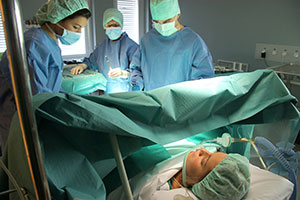 Ovarian insufficiency is a pathological condition characteristic of women of childbearing age, which is based on a violation of the ovulatory function of the follicles. Most often, the pathology is manifested by the syndrome of depleted ovaries or resistant ovaries.
Ovarian insufficiency is a pathological condition characteristic of women of childbearing age, which is based on a violation of the ovulatory function of the follicles. Most often, the pathology is manifested by the syndrome of depleted ovaries or resistant ovaries.
At the heart of ovarian depletion can be various damaging factors, as a result of which the number of active follicles is sharply reduced. Clinically, this situation is characterized by the development of symptoms typical of menopause.
Resistant ovary syndrome also presents with similar symptoms. However, in this case, despite the fact that the number of active follicles is maintained at the same level, they do not fully function, their cyclic maturation stops.
Causes of ovarian failure
 There are primary and secondary ovarian failure. Primary failure is due to the pathology of the ovaries themselves. The most common causes of primary ovarian failure are:
There are primary and secondary ovarian failure. Primary failure is due to the pathology of the ovaries themselves. The most common causes of primary ovarian failure are:
- Congenital genetic disorders;
- The presence of autoimmune diseases, autoimmune thyroiditis, rheumatoid arthritis;
- Exposure to aggressive environmental factors such as radiation;
- Long-term drug exposure, chemotherapy;
- The use of radiation therapy;
- Ovarian damage from trauma or surgery;
- Chronic inflammatory processes;
- Ovarian tuberculosis.
In some cases, the development of pathology is explained by the influence of several pathogenic factors. In others, it is not possible to clarify the reliable reason.
The well-coordinated work of the ovaries is ensured by the influence of hormones produced by the pituitary gland and hypothalamus. The lack of coordination in this system leads to the development of secondary ovarian failure. This pathology is most often based on tumor processes of the hypothalamic-pituitary system.
Disease manifestations
 Insufficiency of the ovaries can be physiological, due to age-related changes and menopause. We are talking about a pathological condition if violations are present in women of childbearing age. In this case, symptoms characteristic of the climacteric period are noted. The most typical signs of the disease are:
Insufficiency of the ovaries can be physiological, due to age-related changes and menopause. We are talking about a pathological condition if violations are present in women of childbearing age. In this case, symptoms characteristic of the climacteric period are noted. The most typical signs of the disease are:
- Violation of the monthly cycle, manifested by the absence of menstruation, amenorrhea;
- Increased sweating;
- Periodic hot flashes;
- Violation of the psycho-emotional sphere in the form of depression, irritability, tearfulness, mood swings;
- The development of insomnia;
- Pain in the region of the heart;
- Decreased sex drive;
- Dryness of the mucous membranes of the external genital organs, due to a change in the nature of the secretion produced;
- Changes in hormone levels.
Congenital anomalies lead girls to develop symptoms such as late puberty, underdevelopment of the gonads, an unstable cycle, irregular menstruation, or amenorrhea. With secondary ovarian failure, clinical signs of damage to the pituitary gland or hypothalamus, the development of cerebral symptoms come to the fore.
Possible complications
A decrease in the level of hormones produced by the ovaries leads to progressive atrophic processes in the gonads, atrophic colpitis, a decrease in bone density and the development of osteoporosis. Patients may develop dry eye syndrome. The most serious complication of insufficient ovarian function is a violation of the ability to produce eggs, that is, the development of infertility.
Diagnostics and treatment in the clinic K + 31
 Diagnostics and treatment at the K + 31 clinic is carried out taking into account the latest achievements in reproductive medicine, for which the latest methods of laboratory and hardware diagnostics are used. Intravaginal ultrasound allows not only to clearly visualize the structure of the ovaries, but also to identify active follicles, to assess their activity. The study of the level of hormones in the blood allows for differential diagnosis of primary and secondary insufficiency. An increase in the level of follicle-stimulating hormone indicates direct damage to the ovaries, while in the secondary process, a decrease in this indicator is characteristic. In the event that the hereditary nature of the disease is not excluded, karyotyping is performed to identify chromosomal abnormalities.
Diagnostics and treatment at the K + 31 clinic is carried out taking into account the latest achievements in reproductive medicine, for which the latest methods of laboratory and hardware diagnostics are used. Intravaginal ultrasound allows not only to clearly visualize the structure of the ovaries, but also to identify active follicles, to assess their activity. The study of the level of hormones in the blood allows for differential diagnosis of primary and secondary insufficiency. An increase in the level of follicle-stimulating hormone indicates direct damage to the ovaries, while in the secondary process, a decrease in this indicator is characteristic. In the event that the hereditary nature of the disease is not excluded, karyotyping is performed to identify chromosomal abnormalities.
Treatment of ovarian failure is complex. The main method is to influence the endocrine, genetic, emotional and reproductive status. As therapeutic measures, hormone replacement therapy, physiotherapy procedures, electrophoresis, hydrotherapy, massage, acupuncture are used. Treatment is carried out using vitamin therapy, phytoestrogens.
However, at the moment, drug therapy has not been developed that improves ovarian function, restores fertility, that is, the ability to reproduce offspring. Although some women with resistant ovary syndrome may have spontaneous ovulation, in most cases, endocrine infertility is a serious problem when trying to conceive. The main treatment for this pathology is in vitro fertilization (IVF). This does not exclude the use of a donor egg.
The advantages of the K + 31 clinic are an experienced team of reproductive specialists who have helped hundreds of women get pregnant and give birth to a healthy baby. An excellent material and technical base and the use of the latest equipment allows us to carry out all stages of treatment at the highest level.
